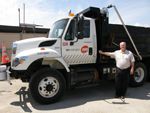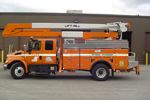Growing Interest
Featuring a larger expo hall where a wide range of vehicle systems in or nearing production for electric, plug-in hybrid, hybrid electric, hydraulic hybrid and work-site electrification were on display, the newly renamed Hybrid, Electric and Advanced Truck Users Forum (HTUF) held its annual meeting in Baltimore this past fall. The 2011 HTUF conference also had very significant participation from hybrid and electric truck manufacturers and suppliers, as well as fleets.
Utility Working Group
The HTUF Hybrid Utility Truck Working Group, consisting of more than 20 large fleets focusing on platforms for the utility industry and related uses, is now actively working on Class 4 and 5 applications and is reviewing plug-in hybrid requirements. This group is credited with fostering the launch of Class 6 and 7 commercial hybrid trucks from several manufacturers and has as parts of its current focus aerial lift trouble or “bucket” trucks in the medium- and heavy-duty weight range.
For the development of Class 4 and 5 hybrid work trucks, the working group is committed to developing preproduction vehicles for field evaluation. On its list of key performance parameters that will form the basis for vehicle specifications are:
• Reliability and durability that meet or exceed baseline vehicles
• Fuel economy improvement of 50 percent over baseline vehicles
• Payload loss of a maximum 500 pounds
• Engine-off power or idling for two to three hours at work sites
• Acceleration rate of a loaded unit that meets or exceeds baseline vehicles
• Startability of 15 percent at 20 mph
• Body and boom that are interchangeable with baseline trucks
• Gradeability of 15 to 30 percent at GVWR
• Top speed of 65 to 75 mph
• Fuel preference for diesel
• Engine-off electric drive or “Creep Mode” available up to 20 mph
• Variable shift points and RPM settings for different applications
• Exportable power of 3.5 kW single phase that meets industry standards
• Towing ability of 1,000 pounds
• In-cab display for driver feedback
Telecom Working Group
The HTUF Telecom Working Group released a request for information to OEMs and suppliers for Class 2 to 4 hybrid or ePTO trucks used in trouble response, spooling/splicing or light aerial applications. Respondents met with the working group at the recent conference and had the opportunity to ask direct questions of telecom companies. Vehicle specifications and key performance parameters are being refined and plans call for demonstration trucks to be available starting in late 2012.
HTUF is a national user-driven program to speed the commercialization of medium- and heavy-duty hybrid and high-efficiency technologies. It is operated by CALSTART in partnership with the U.S. Army’s National Automotive Center, with project support from the Hewlett Foundation and the Department of Energy. Visit www.htuf.org for more.
Electric Vehicles
CALSTART’s E-Truck Task Force (E-TTF) also met during the HTUF 2011 National Conference. The goal of the E-TTF is to speed and support effective electric truck production. The key recommendations of the task force are as follows:
• Call on industry to institute a battery-leasing model, link sales expansion to adequate parts and support networks, and increase quality control.
• Maintain or increase research and development for these technologies.
• Seek support incentives for incremental costs.
• Encourage fleets to require a service turnaround minimum before purchase.
• Create a commercial electric truck charge rate and eliminate/reduce demand charges.
• Create a clearinghouse for data-sharing on e-trucks.
To address the need for better guidance on building a business case for e-trucks, the task force developed an “E-Truck Business Case Calculator” that illustrates the best applications and ways to use an electric truck to recoup the initial purchase investment.
To help e-truck fleets understand their options, trade-offs and costs when setting up an EV charging infrastructure, the E-TTF created an infrastructure planning template based on fleet size. The template addresses power requirements, cost estimates, site considerations and availability of subsidies.
The E-TTF recommendations are now being used as an action plan for industry, fleet and policy activities. After receiving feedback on the E-TTF’s findings and proposed recommendations, CALSTART will publish this information. Visit www.calstart.org/Projects/E-Truck-Project.aspx for more.
EEI Guidebook
Edison Electric Institute (EEI) has released a guidebook to help utilities prepare for new electric cars and trucks. The report, “The Utility Guide to Plug-In Electric Vehicle Readiness,” acts as a road map for electric utilities to get the most benefit from this innovative technology.
The EEI guide focuses on the four areas that every electric utility will need to address to make sure they are ready for plug-in electric vehicles (PEVs) to plug into their service area:
• Getting the utility up to speed – The structure and organizational changes that a utility will need to address, as well as the value of adding PEVs to their fleets.
• Enhancing the customer experience – The educational topics and communication channels that will help utilities get their PEV-owning customers up to speed.
• Key passengers to include – The guide offers advice on engaging key third parties such as state regulators; federal, state and local governments; and additional stakeholder collaborations.
• Plugging into the grid – This section looks at how much power PEVs use, ensuring grid and distribution system readiness; helping customers plug in; and streamlining the charging station installation process.
To download a copy, visit www.eei.org/newsroom/energynews/Pages/20111115.aspx.
Smith Electric Vehicles Expands Production
Smith Electric Vehicles Corp. has announced it will expand its U.S. operations in 2012 by adding a manufacturing facility in New York to build the zero-emission Newton, its all-electric medium-duty vehicle.
The Newton is offered as a chassis cab that can be configured for use in utility operations. The vehicle is offered in a GVW range from 16,500 to 26,400 pounds and in 154-, 177- and 201-inch wheelbases. The Newton has a range of up to 150 miles.
The new facility, Smith’s second U.S. manufacturing, sales and service center, will join existing operations in Kansas City, Mo. The first Newton vehicles are planned for production in New York in the second half of 2012. Smith’s investment in its new plant is being augmented by city and state incentives of approximately $11 million.
New York Governor Andrew Cuomo has also announced the development of a federally funded, multiyear commercial electric vehicle buyer incentive program to accelerate adoption and allow for fleet conversion throughout New York. The New York State Department of Transportation has committed $10 million in federal Congestion Mitigation and Air Quality funding for the first year, which will be offered in the form of vouchers of up to $20,000 per vehicle. The program will be managed by the New York State Energy Research and Development Authority, and will offer voucher incentives to the purchasers of any qualified all-electric vehicle over 10,000 pounds GVW regardless of manufacturer. Visit www.smithelectric.com for more.
Protean Electric Projects Retrofit Market Growth
An all-new retrofit market will grow to a half-million vehicles by 2020, according to Protean Electric, which has developed an in-wheel motor electric drive system for light-duty vehicles. “Rising operating costs, shrinking budgets and green mandates are hard to balance when your fleet still has a job to do every day,” said Ken Stewart, Protean’s vice president of sales and marketing. “The time is right for a system that can add the benefits of this technology to light-duty vehicles that are already in service.”
The vast majority of this new retrofit market will come from converting light-duty government and commercial fleets. The Protean Drive in-wheel solution, which can be integrated into a broad range of vehicles, uses motors that can be fitted to conventional rear axles and installed in the space behind a wheel to produce up to 110 HP. Each motor has its own self-contained inverter controller. Visit www.proteanelectric.com for more.
PG&E Helps Unveil VIA Motors eREV
Pacific Gas and Electric Company joined VIA Motors in unveiling the first extended-range electric pickup truck for utilities. The utility partnered with VIA in 2008 to develop the trucks, called extended-range electric vehicles or eREVs, and already operates two of the trucks.
The VIA Motors eREV powertrain, powered by Symetron SmartDrive, was designed to work in light-duty trucks from GM, Ford and Dodge. An extended-range electric work truck comes with an optional onboard inverter that can be used in place of a tow-behind generator. The eREV trucks run the first 40 miles solely on electricity before switching to gasoline. For electric utilities, the trucks potentially can provide on-site power using a 15 kW capacity inverter.
In addition to the full-size pickup, VIA will offer a four-wheel drive SUV and a three-quarter-ton cargo van. The company has begun taking orders for its extended range electric pickup. Production is scheduled to begin in 2012. Visit www.viamotors.com for more.
Freightliner Custom Chassis Corporation and Enova Partner to Unveil Green for Free Program
Freightliner Custom Chassis Corporation (FCCC) and Enova, a developer of hybrid-electric and all-electric drive systems and drive system components, have launched a program to make electric vehicles more accessible to fleets.
The Green for Free program allows fleets to purchase all-electric vehicles for the cost of a diesel-powered commercial vehicle. The savings fleets incur from the reduced maintenance and fuel savings of the electric vehicles are then used over a period of time to cover the incremental expense of the technology. FCCC and Enova plan to deploy a total of 3,000 alternative-fuel vehicles within a two-year time frame beginning no later than the third quarter of 2012 as a result of the Green for Free program.
The Green for Free program will utilize the FCCC All-Electric Walk-in Van chassis powered by the Enova drive system. Enova and FCCC developed an integration method for both new and retrofit applications. FCCC’s all-electric chassis is built upon the FCCC MT-45 chassis with a GVWR of 14,000 to 19,500 pounds. Visit www.freightlinerchassis.com and www.enovasystems.com for more.
Propane
Trucks fueled by propane autogas, coupled with the cleaner-burning properties of propane, can decrease maintenance costs and extend engine life, according to the Propane Education & Research Council. Vehicles fueled by propane autogas, the most widely used alternative fuel, emit up to 12 percent less carbon dioxide, about 20 percent less nitrogen oxide and up to 60 percent less carbon monoxide than gasoline‐powered vehicles. More than 270,000 vehicles in the United States run on propane autogas, according to the U.S. Department of Energy.
Light- and medium-duty trucks fueled by propane autogas are available from industry-leading manufacturers, including Ford Motor Company, through collaboration with ROUSH CleanTech and General Motors, and through collaboration with CleanFUEL USA. The North American market for vehicles fueled by propane autogas is gaining momentum as more fleet managers become aware of the environmental and economic advantages.
Southern California’s City of Cypress is using ROUSH CleanTech propane autogas vehicles. The city added two Ford F-250 pickups fueled by the alternative fuel. “The City of Cypress is always looking for opportunities to put green vehicles in our fleet, and it’s important to move toward greener fleets when possible,” said Doug Dancs, the city’s director of public works. “Plus, the choice for propane was an easy one since we have had a propane fueling station in place since the early 1980s.”
King County, Wash., is also using vehicles that operate on propane autogas. Its fleet now includes seven Ford F-250s, one Ford F-350 extended cab pickup and one Ford E-250 cargo van with ROUSH CleanTech systems. “Public fleets in particular have a responsibility to take the lead and take steps to achieve significant greenhouse gas reductions within their own fleets,” said Robert Toppen, King County Department of Transportation equipment supervisor.
Visit www.autogasusa.org, www.roushcleantech.com and www.cleanfuelusa.com for more.
Compressed Natural Gas
Compressed natural gas (CNG) is an abundant domestic alternative fuel that offers significant advantages over gasoline. CNG’s per-gallon equivalent is 30 percent less expensive. In many areas of the country there is already infrastructure in place to effectively operate natural gas vehicles and more public-access fueling stations are becoming available. Another major advantage of CNG is 25 percent fewer CO2 emissions than standard gasoline-powered engines.
Strategic Partnership to Produce Natural Gas Vehicles
Leggett & Platt Commercial Vehicle Products (L&P CVP) has partnered with Landi Renzo USA to implement alternative fuel systems using CNG. L&P CVP will install Landi Renzo’s CNG fuel system at its Ford ship-thru facility in Elyria, Ohio, and will offer three- and four-tank options for installation on Ford’s E-250 and E-350 Cargo and Passenger vans. The 21 and 27 gasoline-gallon-equivalent tanks are part of a system that complies with Federal Motor Vehicles Safety Standards and Regulations, is certified by the EPA and is 50-state compliant through CARB. Visit www.leggettcvp.com and www.landiusa.com for more.
IMPCO Receives CARB Certification
IMPCO Automotive, a business unit of Fuel System Solutions Inc., has received certification by the California Air Resources Board (CARB) for its CNG fuel systems on several Ford and General Motors vehicles. Included are:
• Ford E-150/250 and 250 Econoline vans with the 5.4-liter V8 engines
• Ford E-450 Econoline cutaway cab chassis with the 6.8-liter 2v V8 engines
• Ford F-450/550 Super Duty trucks with the 6.8-liter 3v V8 engines
• General Motors 2500/3500 Express/Savana vans with the 4.8-liter and 6.0-liter V8 engines
• General Motors 4.8-liter V8 engine for heavy-duty applications – 10,001 to 14,000 pounds GVW
• General Motors 6.0-liter V8 engine for heavy-duty applications over 14,000 pounds GVW
Achieving CARB certification is especially important because several states have either adopted or are in the process of adopting California’s strict emissions standards. These states include New York, New Jersey, Massachusetts, Maine, Connecticut, Rhode Island, Pennsylvania, Vermont, New Mexico, Oregon, Washington, Maryland and Florida. IMPCO previously received certification from the U.S. Environmental Protection Agency (EPA) for these vehicles.
Now fielding IMPCO-powered vehicles is the City of Chicago, which has ordered up to 40 CNG-powered Chevrolet Express vans and as many as 40 CNG-powered Chevrolet Silverado pickup trucks. The dedicated CNG fuel systems will be installed on the Chevrolet Express vans at IMPCO Automotive’s alternative fuels conversion plant in Union City, Ind. The fuel systems for the trucks will be installed by IMPCO Automotive’s certified installation partner, Auto Truck Group, in Bartlett, Ill. Visit www.impcoautomotive.com for more.
Daimler Trucks North America Produces 1,000th Natural Gas Truck
Daimler Trucks North America, parent company of Freightliner Trucks, turned over the key to its 1,000th natural gas truck. Freightliner’s natural gas vehicles, including the M2 112 and 114SD, are powered by the Cummins Westport ISL G 8.9-liter engine, the only factory-built, dedicated natural gas engine available in the commercial vehicle market. These factory-installed and warranty-covered CNG tanks come in 60 diesel gallon equivalent (DGE) and 75 DGE configurations.
Freightliner Trucks has also announced that DeKalb County, Ga., has ordered 24 Freightliner Business Class M2 112 CNG trucks. DeKalb County will power the new trucks using its methane gas-to-energy process. The program, which was launched in 2011, converts landfill waste to useable natural gas. By converting the waste to energy, DeKalb County produces enough electricity to run 2,500 homes and will produce enough natural gas to run 600 trucks. To support the gas-to-energy program, DeKalb County is also building two fueling stations. Visit www.freightlinertrucks.com for more.
Hybrids
Hybrid Systems Achieve 200 Million Miles of Service
Eaton Corporation has announced that that customers of its hybrid systems have collectively accumulated more than 200 million miles of service, reducing diesel fuel consumption by 8 million gallons and harmful emissions by 80,000 metric tons. More than 5,500 of Eaton’s hybrid systems are in use today worldwide on trucks and buses. In addition to hybrid electric systems, Eaton began commercial production of its hybrid hydraulic system known as Eaton Hydraulic Launch Assist or Eaton HLA in the fall of 2010.
Eaton has also announced a program that lowers the service replacement cost for its hybrid power systems electronics carriers (PECs) and said it will offer two auxiliary power generator (APG) options for its hybrid electric power systems.
“We are now entering the period when the early adopters of hybrid technology are beginning to require service of the hybrid power batteries outside the factory warranty period,” said Gerard Devito, director of engineering, Eaton Hybrid Power Systems Division. “We are committed to helping fleets receive real value in running cleaner, greener fleets by continuing to lower the overall cost of ownership for hybrid systems and provide a positive return on investment.”
The new program significantly lowers the purchase price of PECs by up to half for utility applications. A standard aftermarket warranty of one year on parts and labor applies, with a two-year extended protection plan available at an additional cost. Starting in October 2011, the program became available through dealerships that elect to participate in this program and are authorized to service Eaton Hybrid Power Systems.
In addition to the PEC service replacement program, Eaton has announced it will offer two APG options in 2012 that will allow fleets to run vital equipment from the vehicle without requiring the engine to idle for power generation. The APG options will meet the power needs for customers using 115-volt single-phase tools and 208-volt three-phase loads. Visit www.eaton.com/hybrid for more.
BAE Unveils Scalable Hybrid Solution
The new BAE Systems HybriDrive family of heavy-duty hybrid electric propulsion systems is scalable to meet a wide range of truck platforms, vocations and duty cycles, including those for hybrid utility trucks. HybriDrive Parallel is based on a single electric machine integrated with the engine and the transmission on medium- to heavy-duty trucks.
www.baesystems.com
International DuraStar
The International DuraStar Hybrid, a diesel hybrid electric medium-duty truck is available with a choice of engines. Included are the MaxxForce 7 in ratings from 220 to 300 HP and 560 to 660 lbs./ft. of torque; the MaxxForce DT with automatic and manual driveline options and eight ratings from 215 to 300 HP and 560 to 860 lbs./ft. of torque; and the MaxxForce 9, also with a full range of automatic and manual driveline options and ratings up to 350 HP.
International’s hybrid vehicle is also equipped with the company’s Diamond Logic Electrical System, which integrates body equipment and the hybrid powertrain as a single piece of equipment. The programmable system features self-calibrating gauges that provide an audible alarm and visible LED indication when displaying a value out of normal operating range. Onboard diagnostics monitor electrical modules and capture diagnostic faults, and trouble codes are stored and displayed on the instrument panel’s built-in LCD screen. The International DuraStar Hybrid can also be equipped with the OEM’s AWARE vehicle intelligence system to allow for real-time data collection, reporting and analysis. Visit www.internationaltrucks.com for more.
XL Hybrids Conversion Systems
A hybrid conversion that transforms new or existing Class 1 through 3 vehicles into hybrid electric units is being readied for sale in 2012 by XL Hybrids. Designed for cargo, utility and shuttle vans and pickup trucks, the system has been undergoing pilot trials with select customers. XL Hybrids adds an electric motor, a lithium-ion battery pack and control software to the vehicle without making significant modifications to the engine or transmission. The parallel hybrid system can be installed as a retrofit on existing vehicles through a network of installation partners or as an upfit onto a new vehicle before delivery from a dealer. Visit www.xlhybrids.com for more.



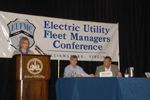



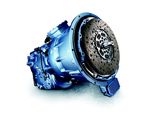
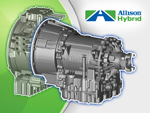 Allison
Allison ALTe Powertrain Technologies
ALTe Powertrain Technologies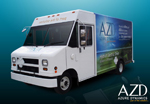 Azure Dynamics
Azure Dynamics Odyne Systems, LLC
Odyne Systems, LLC  Quantum Fuel Systems Technologies Worldwide Inc.
Quantum Fuel Systems Technologies Worldwide Inc.
